Ian Clarke describes a joint Open University Geological Society (OUGS) and Geological Society of London (GSL) visit to St. Peter’s Church, Northampton, followed by a tour of All Saints Church, Brixworth.
As one of the events marking the 200th anniversary of the publication of William Smith’s 1815 Geological Map, it was appropriate that a group of geologists should visit his grave and memorial at St. Peter’s Church in Northampton. This idea was suggested to me at the OUGS 40th Anniversary Symposium in 2012 (held in Northampton), by Dave Williams, one of the OUGS speakers. Dave mentioned that he was on a Geological Society committee planning events for the anniversary year. Something should be organised for Northampton---but as Dave lives in Cornwall, perhaps someone more local should make the arrangements - hence my involvement as I live near Northampton.
So, on 6 September 2015, a group of 10, made up of Geological Society and OUGS members, assembled outside the Ibis Hotel, Marefair, Northampton, and met Dr Diana Sutherland, our guide for the day. Diana is the author of Northamptonshire Stone and an expert on Northamptonshire geology.
Hazelrigg House, 33 Marefair
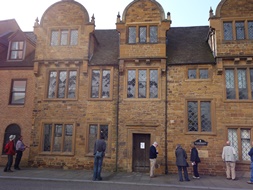
Our first stop was just across the road from the Ibis. Hazelrigg House (Fig.1) is where William Smith died in 1839. What was Smith doing in Northamptonshire? According to Rev R M Serjeantson in his “History of the Church of St. Peter”, 1904: “In August 1839, he was specially invited to attend the meeting of the British Association in Birmingham. On his way he stayed with his friend, Mr G Baker, the antiquary, and with him made several excursions into the neighbouring country. On one of these expeditions he contracted a chill, which led to serious complications, and in a few days put an end to his life. He died on August 28th. At the suggestion of Dr. Buckland, a tablet and bust was erected at St. Peter’s, the cost having been defrayed by a subscription amongst geologists”.
It is not known how long Smith had been friends with George Baker and his sister Anne or how often he came to Northampton. His county map of Northamptonshire is unfinished, so perhaps he was working on this as part of his visit.
Hazelrigg is a Tudor town house, dating from 1570-1580, is built of dark brown sandstone and ironstone from the Northampton Sand Formation. The door case is Cotswold (Taynton?) limestone. There is a local tradition that Cromwell stayed at the house on his way to Naseby (1645). The house survived the Great Fire of Northampton in 1675. The Bakers, who bought the house in 1831, wrote a large, two volume history of Northamptonshire.
As well as looking at the front of the house, later in the morning we were able to peer into the rooms at the rear of the building. This was much to the consternation of the Through the Looking Glass Theatre Company who were rehearsing inside. So much so that one of their leaders came out to see what we were up to. We explained who we were and gave him an information sheet about William Smith. He was very pleased with this, as the theatre group want to do work to bring the history of the building to life. So perhaps William Smith’s dramatic story will inspire a play (though not, we hope, a musical called ‘Strata!’).
St. Peter’s Church
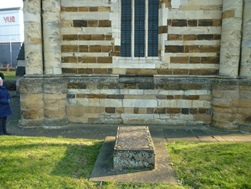
Just a short way from Hazelrigg House is St. Peter’s Church, described in the recent new edition of Pevsner’s Northamptonshire as “the most interesting Norman church in Northamptonshire and indeed one of the most exceptional Norman churches in the country.”
Diana led us to William Smith’s grave in the churchyard (Fig.2). Here she read out the details of his death certificate and the obituary notice from the Northampton Mercury. John Phillips, Smith’s nephew, had arrived before Smith died and was present at the funeral. The gravestone is made of very weathered sandstone (New Red Sandstone, not local, source unknown) and the inscription is barely legible.
St. Peter’s dates from AD1160 and occupies the site of an earlier Saxon church. It is built of local brown sandstone and ironstone of the Northampton Sand, with decorative features made of Blisworth Limestone, giving a typical Northamptonshire polychrome effect. Inside the church there is a memorial bust (Fig.3), by Matthew Noble, of William Smith. The inscription on the marble plinth reads:
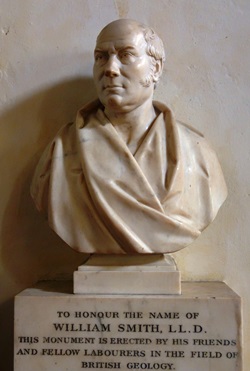
To honour the name of William Smith, LLD. This monument is erected by Friends and Fellow-labourers in the same field of British Geology. Born 23rd March, 1769, at Churchill in Oxfordshire, and trained to the Profession of a Civil Engineer and Mineral Surveyor. He began, in 1791, to survey collieries and plan canals in the vicinity of Bath, and having observed that several strata of that district were characterised by peculiar groups of organic remains he adopted this fact as a principle of comparison, and was by it enabled to identify the strata in distant parts of this island, to construct sections, and to complete and publish in 1815 a Geological Map of England and Wales. By thus devoting, during his whole life, all the power of an observing mind to the advancement of one branch of Science, he gained the title of the “Father of English Geology”. A plaster replica of this bust (without the inscription) stands in Burlington House.
Inside the church, Diana spoke about the building’s architectural history, including many Norman alterations and its partial rebuilding by George Gilbert Scott in 1850, building stones, and stone carvings, in particular a magnificent Anglo-Saxon tomb-slab decorated with a Green Man and fantastic birds and beasts. It dates from the 10th or 11th Century and is reputed to be the grave slab of St. Ragener.
All Saints’ Church, Brixworth
After lunch, we continued the Saxon theme by visiting All Saints’ Church, Brixworth (Fig.4), a few miles north of Northampton. All Saints’ is one of the most outstanding examples of Anglo-Saxon architecture in England. It dates from the 8th and 9th Centuries. Diana has spent many years working on identifying the many building stones used, especially in the Saxon parts of the church, and tracing the history of the building’s development.
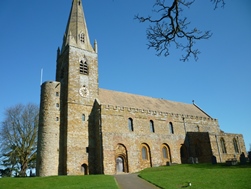
We began our tour inside the church and Diana told us about the main points in the building’s history—Saxon, Later Medieval, and especially the 19th Century restoration by Rev. C.F. Watkins. Watkins did a wonderful job, restoring Anglo-Saxon features, rebuilding the polygonal apse, and revealing the ambulatory that had been covered by medieval stonework. The ambulatory is a semi-circular, sunken, outer ring-crypt, a walkway for pilgrims, surrounding the apse. A highlight of the tour was to be able to go up into the stair turret and see the use of tufa in the construction of the turret’s stair vault.
Outside Diana treated us to a geological feast (Figs. 5 & 6), as we examined some of the building stones around a small door on the south side of the tower. These include bedded tuffs, diorite, Markfieldite, granite, mica hornfels, Swithland slate, grey and red Triassic sandstones, in addition to many Roman bricks. None of these stones is local, all originating in Leicestershire, and they are thought to have been reclaimed from Roman buildings in Leicester (Roman name
Ratae) and brought about 35km to Brixworth, for use in building this very prestigious church.
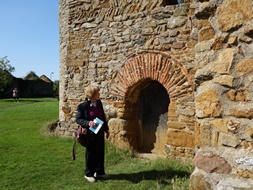
As well as these imported igneous rocks and sandstones, there is plenty of Northamptonshire stone. This includes eight types of Northampton Sand, Blisworth Limestone and tufa. Northampton Sand was quarried locally, but the Blisworth Limestone may come from Towcester, 25km away. The tufa could have been found locally, but, like many of the church’s stone could have come from a Roman site.
This was a fascinating day of geology, history and architectural delights. Thanks to Diana for showing us such wonderful buildings and explaining everything so well.
Thanks are also due to the Churches Conservation Trust for allowing us access to St. Peter’s and to the Friends of All Saints Church, Brixworth who enabled us to go up into the stair turret.
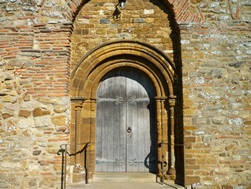 Further reading
Further reading
- Bailey, B, Pevsner, N, Cherry, B Northamptonshire, The Buildings of England. Yale University Press, 2013 ISBN 978 0 300 18507 2
- Serjeantson, Rev. R.M. History of the Church of St. Peter, Northampton 1904
- Sutherland, D.S. Northamptonshire Stone, Dovecote Press, 2003 ISBN 1 904349 17 X
- Sutherland, D.S. The building of Brixworth Church, The Friends of All Saints Church, Brixworth, 2014 ISBN 0 9544092 9 9
- Winchester, S The map that changed the world, Viking, 2001 ISBN 0 670 88407 3
Ian Clarke
September 2015